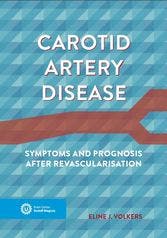Eline Volkers
Carotid artery disease: symptoms and prognosis after revascularisation

- Date
- (Co-) Supervisors
- 11-12-2018
- prof.dr. A. Algra, prof.dr. L.J. Kappelle, dr.ir. J.P. Greving
Summary
Stroke is a major cause of morbidity and mortality worldwide. About 20% of all transient ischaemic attacks (TIAs) and ischaemic strokes are caused by atherosclerotic carotid artery stenosis. Patients who suffer a TIA or ischaemic stroke caused by severe carotid artery stenosis are at high risk of recurrent stroke. Carotid revascularisation procedures (carotid stenting or carotid endarterectomy) in addition to medical treatment aim to reduce the risk of recurrent stroke in these patients. The benefit of carotid revascularisation for an individual patient depends on the balance between the long-term risk of vascular events on medical treatment and the risk of complications during and after a carotid revascularisation procedure. Some patient characteristics, such as higher age, are known to increase the complication risk of carotid stenting. Identification of such characteristics may improve benefit of carotid revascularisation procedures. In this thesis, the value of prognostic factors and prediction models for risk of vascular events after carotid revascularisation procedures is examined. We found that overweight patients with symptomatic carotid stenosis have a lower risk of stroke or death in the postprocedural period after carotid stenting or endarterectomy compared with normal weight patients. In addition, we found that age may have a different impact on the safety of carotid stenting compared with carotid endarterectomy in patients with and without a history of coronary heart disease. Prediction models that combine patient characteristics to predict risk of vascular complications after carotid revascularisation may help physicians to identify patients at high and low risk of complications. In a systematic review of the literature, we found that many prediction models exist for the prediction of procedural and long-term risk of vascular complications. Age, diabetes mellitus, heart failure, and presence of contralateral carotid artery stenosis of ≥50% or occlusion were most commonly used as predictors for procedural and long-term complication risk. Application of the existing prediction models to a new setting and development of new prediction models for the prediction of vascular complications after carotid revascularisation resulted in poor to moderate predictive performance. It was therefore concluded that most prediction models for procedural or long-term risk of vascular events after carotid stenting or endarterectomy based on readily available patient characteristics have limited ability to identify patients at high risk of complications.
